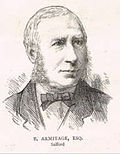| Salford West | |
|---|---|
| Former borough constituency for the House of Commons | |
 1885 map by Robert Owen Jones | |
| 1885–1983 | |
| Seats | one |
| Created from | Salford |
| Replaced by | Eccles and Salford East [1] |
Salford West was a parliamentary constituency in the City of Salford in Greater Manchester from 1885 until 1983. [2] It returned one Member of Parliament (MP) to the House of Commons of the Parliament of the United Kingdom.
Contents
- History
- Boundaries
- Members of Parliament
- Elections
- Elections in the 1880s
- Elections in the 1890s
- Elections in the 1900s
- Elections in the 1910s
- Elections in the 1920s
- Elections in the 1930s
- Elections in the 1940s
- Elections in the 1950s
- Elections in the 1960s
- Elections in the 1970s
- References
- Further reading
- External links





